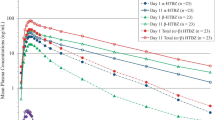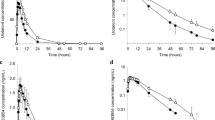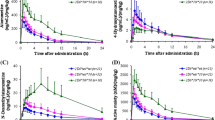Abstract
Objective
Paroxetine is believed to be a substrate of CYP2D6. However, no information was available indicating drug interaction between paroxetine and inhibitors of CYP2D6. The aim of this study was to examine the effects of terbinafine, a potent inhibitor of CYP2D6, on pharmacokinetics of paroxetine.
Methods
Two 6-day courses of either a daily 150-mg of terbinafine or a placebo, with at least a 4-week washout period, were conducted. Twelve volunteers took a single oral 20-mg dose of paroxetine on day 6 of both courses. Plasma concentrations of paroxetine were monitored up to 48 h after dosing.
Results
Compared with the placebo, terbinafine treatment significantly increased the peak plasma concentration (Cmax) of paroxetine, by 1.9-fold (6.4 ± 2.4 versus 12.1 ± 2.9 ng/ml, p < 0.001), and the area under the plasma concentration-time curve from zero to 48 h [AUC (0–48)] of paroxetine by 2.5-fold (127 ± 67 vs 318 ± 102 ng/ml, p < 0.001). Elimination half-life differed significantly (15.3 ± 2.4 vs 22.7 ± 8.8 h, p < 0.05), although the magnitude of alteration (1.4-fold) was smaller than Cmax or AUC.
Conclusion
The present study demonstrated that the metabolism of paroxetine after a single oral dose was inhibited by terbinafine, suggesting that inhibition of CYP2D6 activity may lead to a change in the pharmacokinetics of paroxetine. However, further study is required to confirm this phenomenon at steady state.

Similar content being viewed by others
References
Burrows GD, McIntyre IM, Judd FK, Norman TR (1988) Clinical effects of serotonin reuptake inhibitors in the treatment of depressive illness. J Clin Psychiatry 49(Suppl):18–22
Gunasekara NS, Noble S, Benfield P (1998) Paroxetine. An update of its pharmacology and therapeutic use in depression and a review of its use in other disorders. Drugs 55:85–120
Kaye CM, Haddock RE, Langley PF, Mellows G, Tasker TC, Zussman BD, Greb WH (1989) A review of the metabolism and pharmacokinetics of paroxetine in man. Acta Psychiatr Scand Suppl 350:60–75
van Harten J (1993) Clinical pharmacokinetics of selective serotonin reuptake inhibitors. Clin Pharmacokinet 24:203–220
Haddock RE, Johnson AM, Langley PF, Nelson DR, Pope JA, Thomas DR, Woods FR (1989) Metabolic pathway of paroxetine in animals and man and the comparative pharmacological properties of its metabolites. Acta Psychiatr Scand (Suppl) 350:24–26
Sindrup SH, Brosen K, Gram LF, Hallas J, Skjelbo E, Allen A, Allen GD, Cooper SM, Mellows G, Tasker TC et al (1992) The relationship between paroxetine and the sparteine oxidation polymorphism. Clin Pharmacol Ther 51:278–287
Sindrup SH, Brosen K, Gram LF (1992) Pharmacokinetics of the selective serotonin reuptake inhibitor paroxetine: nonlinearity and relation to the sparteine oxidation polymorphism. Clin Pharmacol Ther 51:288–295
Bloomer JC, Woods FR, Haddock RE, Lennard MS, Tucker GT (1992) The role of cytochrome P4502D6 in the metabolism of paroxetine by human liver microsomes. Br J Clin Pharmacol 33:521–523
Skjelbo E, Brosen K (1992) Inhibitors of imipramine metabolism by human liver microsomes. Br J Clin Pharmacol 34:256–261
Ramamoorthy Y, Tyndale RF, Sellers EM (2001) Cytochrome P450 2D6.1 and cytochrome P450 2D6.10 differ in catalytic activity for multiple substrates. Pharmacogenetics 11:477–487
Laugesen S, Enggaard TP, Pedersen RS, Sindrup SH, Brosen K (2005) Paroxetine, a cytochrome P450 2D6 inhibitor, diminishes the stereoselective O-demethylation and reduces the hypoalgesic effect of tramadol. Clin Pharmacol Ther 77:312–323
Saito M, Yasui-Furukori N, Nakagami T, Furukori H, Kaneko S (2005) Dose-dependent interaction of paroxetine with risperidone in schizophrenic patients. J Clin Psychopharmacol 25:527–532
Clayton YM (1989) In vitro activity of terbinafine. Clin Exp Dermatol 14:101–103
Balfour JA, Faulds D (1992) Terbinafine. A review of its pharmacodynamic and pharmacokinetic properties, and therapeutic potential in superficial mycoses. Drugs 43:259–284
Abdel-Rahman SM, Nahata MC (1997) Oral terbinafine: a new antifungal agent. Ann Pharmacother 31:445–456
Abdel-Rahman SM, Marcucci K, Boge T, Gotschall RR, Kearns GL, Leeder JS (1999) Potent inhibition of cytochrome P-450 2D6-mediated dextromethorphan O-demethylation by terbinafine. Drug Metab Dispos 27:770–775
Vickers AE, Sinclair JR, Zollinger M, Heitz F, Glanzel U, Johanson L, Fischer V (1999) Multiple cytochrome P-450s involved in the metabolism of terbinafine suggest a limited potential for drug-drug interactions. Drug Metab Dispos 27:1029–1038
Venkatakrishnan K, von Moltke LL, Greenblatt DJ (2000) Effects of the antifungal agents on oxidative drug metabolism: clinical relevance. Clin Pharmacokinet 38:111–180
Abdel-Rahman SM, Gotschall RR, Kauffman RE, Leeder JS, Kearns GL (1999) Investigation of terbinafine as a CYP2D6 inhibitor in vivo. Clin Pharmacol Ther 65:465–472
Madani S, Barilla D, Cramer J, Wang Y, Paul C (2002) Effect of terbinafine on the pharmacokinetics and pharmacodynamics of desipramine in healthy volunteers identified as cytochrome P450 2D6 (CYP2D6) extensive metabolizers. J Clin Pharmacol 42:1211–1218
van der Kuy PH, Hooymans PM (1998) Nortriptyline intoxication induced by terbinafine. Br Med J 316:441
O’Reardon JP, Hetznecker JM, Rynn MA, Baldassano CF, Szuba MP (2002) Desipramine toxicity with terbinafine. Am J Psychiatry 159:492
Castberg I, Helle J, Aamo TO (2005) Prolonged pharmacokinetic drug interaction between terbinafine and amitriptyline. Ther Drug Monit 27:680–682
Ueda M, Hirokane G, Morita S, Okawa M, Watanabe T, Akiyama K, Shimoda K (2006) The impact of CYP2D6 genotypes on the plasma concentration of paroxetine in Japanese psychiatric patients. Prog Neuropsychopharmacol Biol Psychiatry 30:486–491
Sawamura K, Suzuki Y, Someya T (2004) Effects of dosage and CYP2D6-mutated allele on plasma concentration of paroxetine. Eur J Clin Pharmacol 60:553–557
Lam YW, Gaedigk A, Ereshefsky L, Alfaro CL, Simpson J (2002) CYP2D6 inhibition by selective serotonin reuptake inhibitors: analysis of achievable steady-state plasma concentrations and the effect of ultrarapid metabolism at CYP2D6. Pharmacotherapy 22:1001–1006
Penzak SR, Reddy YS, Grimsley SR (2000) Depression in patients with HIV infection. Am J Health Syst Pharm 57:376–386
Acknowledgments
None of the authors and their institutes has any conflicts of interest. This study was supported by a Fund for the Promotion of International Scientific Research, a Research Fund from Hirosaki University School of Medicine and a grant from the Hirosaki Research Institute for Neurosciences.
Author information
Authors and Affiliations
Corresponding author
Rights and permissions
About this article
Cite this article
Yasui-Furukori, N., Saito, M., Inoue, Y. et al. Terbinafine increases the plasma concentration of paroxetine after a single oral administration of paroxetine in healthy subjects. Eur J Clin Pharmacol 63, 51–56 (2007). https://doi.org/10.1007/s00228-006-0217-9
Received:
Accepted:
Published:
Issue Date:
DOI: https://doi.org/10.1007/s00228-006-0217-9




